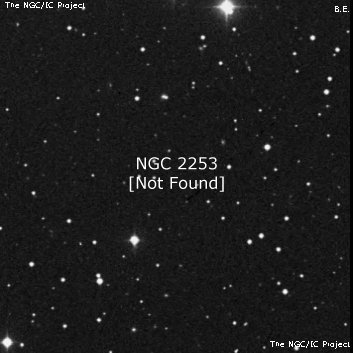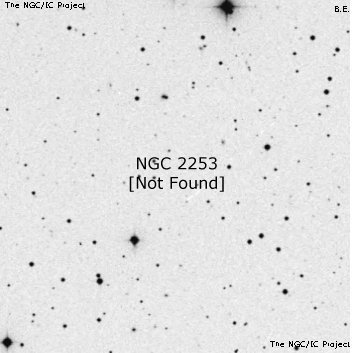NGC/IC Project Restoration Effort
(This is a very very beta version)
NGC2253


Basic Information
Location and Magnitude
Right Ascension: 6:42:0.0
Declination: +65:51:0
Constellation: CAM
Visual Magnitude:
Historic Information
Discoverer: Herschel W.
Year of discovery: 1788
Discovery aperture: 18.7
Observational
Summary description: vF, st eS
Sub-type: *Grp
Corwin's Notes
=====
NGC 2253 may be the elongated (southwest to northeast) group of ten stars that
I've listed in the table. There is nothing at W. Herschel's position (06 36.9
+65 54, 1950), nor is there much to suggest a systematic error in the
positions of the other objects found that night (NGC 2347 = III 746, though
see this for some confusion; and NGC 2403 = V 44). Herschel's description --
"A vF patch or S cl of eS st(ars)" -- as well as the fact that he included
this object in his class VII (number 54) suggests that we should be looking
for a small, tight group of faint stars.
Alister Ling found such a group about 34 arcmin north of WH's position. Brent
Archinal and Steve Hynds have this included as a possible identity as NGC 2253
in "Star Clusters", and Brent discusses Alister's observation at greater
length in "Non-Existent Star Clusters". Recently (March 2007), Bob Jardine,
using a 12.5-inch reflector, looked at Alister's object, and found that its
eyepiece appearance matched WH's description very well. Based on that, I've
adopted this as the probable identification of WH's object. This would make
his declination about half a degree off, not an unusual error for him to make.
There is another scattered group of 10 or 15 stars of magnitudes 14 to 16 at
06 37.4 +66 22 (1950), closer still to being half a degree off, but I would
not call it a "patch" -- it is too scattered.
Some have suggested that Herschel's description might just fit UGC 3511 (06 38
45.8 +65 15 22, 1950), a rather patchy late-type spiral galaxy, but the
position is off by random amounts in both coordinates, and the patchiness
probably much too faint to register as such in a telescope the size of WH's.
Similarly, the CGCG object at 06 38.2 +65 43 (1950) is probably also not WH's
object.
The Herschel Archive entry agrees with the published position and description
published in PT and is internally consistent. I've suggested to Bob that he
and other observers scour the field for a degree or so around WH's position
for other asterisms similar to the one found by Alister. If none are found,
then we can take Alister's as a likely candidate.
Finally, Steve Gottlieb looked at this field in March 2014. Here are his
notes:
The surrounding field was examined at 125x (49' field of view) and the only
object that caught my attention was a 4' string containing a dozen mag 13-14
stars oriented SW-NE. In addition, a larger group of mag 14 stars is just
south (though detached), with the total size of both groups roughly 10'.
This asterism is penned in by some brighter stars: mag 9.6 star (SAO 13933)
is just north of the group, mag 7.7 HD 47522 is southeast and mag 7.2
HD 47215 is roughly 10' S.
Checking a 1/2 degree field centered on the northern clump of stars -- Steve's
four-arcmin string -- the DSS2R image easily shows the larger grouping to the
south. I was impressed with the appearance of a "cluster" that both groups
made together, and have included it in the position table. This may not be a
real cluster, and it is certainly well off WH's position, but it looks like
the best candidate for NGC 2253 in the area.
Steve's Notes
=====
NGC 2253
24" (3/22/14): this number might apply to a fairly rich string of stars about 30' north of William Herschel's position. The surrounding field was examined at 125x (49' field of view) and the only object that caught my attention was a 4' string containing a dozen mag 13-14 stars oriented SW-NE. In addition, a larger group of mag 14 stars is just south (though detached), with the total size of both groups roughly 10'. This asterism is penned in by some brighter stars: mag 9.6 star (SAO 13933) is just north of the group, mag 7.7 HD 47522 is southeast and mag 7.2 HD 47215 is roughly 10' S.



